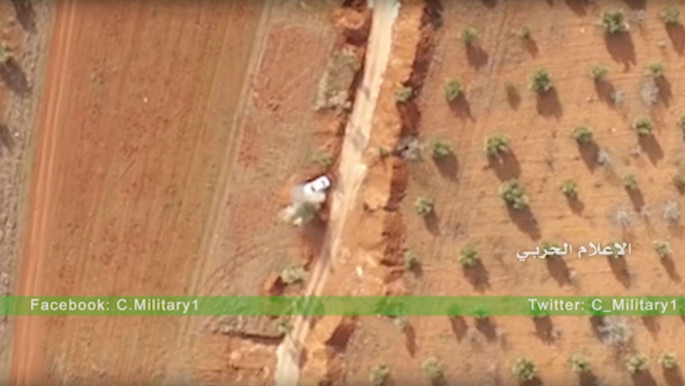Syrian militants using weaponised drones to bomb and spy
Armed groups in the Syrian war such as Hizballah and the Islamic State group have learned how to weaponise surveillance drones and are beginning to use them against each other.
A video belonging to an al-Qaeda offshoot - Jund al-Aqsa - purportedly shows a drone dropping a bomb on a Syrian military barracks.
In another video, small explosives purportedly dropped by the Iran-backed Shia militant group Hizballah allegedly targets the militant group Jabhat Fath al-Sham, formerly known as the al-Nusra Front.
A Washington military official, who spoke anonymously, said the US military is aware of the development and that commanders have warned troops to take cover if they see what they might have once dismissed as a surveillance drone.
The head of the Airwars project, which tracks the international air war in Iraq, Syria and Libya, said the weaponised drones are clumsy but will scare people.
"There are a million ways you can weaponise drones - fire rockets, strap things in and crash them," Chris Woods said. He added: "This is the stuff everyone has been terrified about for years, and now it's a reality."
A number of militant groups in the Middle East, including IS, Jund al-Aqsa and Jabhat Fath al-Sham, as well as Hizballah and Hamas, have all released videos indicating that they have surveillance and reconnaissance drones.
Syrian rebels and militias loyal to President Bashar al-Assad have also been flying cheap quad- and hexacopters as early as 2014 to spy on each other.
 |
|
| A Hizballah video shows small explosives dropped on Jabhat Fath al-Sham targets [YouTube] |
The surveillance drones have allowed those groups to collect data on enemy bases, battlefield positioning and weaponry and improve targeting.
IS released a sophisticated propaganda video in 2014, The Clanging of the Swords, Part 4, boasting about its capture of the Iraqi city of Fallujah. The video opens with drone footage over the western Iraqi city before cutting to violent ground footage depicting its advance across the country.
Hizballah has claimed to have armed-drone capabilities for nearly two years, but a recent video of bomblets hitting a militant camp near the Syrian town of Hama is the first known documentation.
The majority of these groups have access only to lightweight store-bought drones, similar to those available in the US, ranging in price from $1,000 to $3,000 - certainly not enough to support a large bomb or rocket. Hizballah is an exception, receiving most of its munitions - including its drones - from Iran.
"It's not going to change the overall balance of power in the region, but it matters by the very fact that these are things that are normally beyond the capability of insurgents or terrorist groups," said Peter Singer, author of the book Wired for War: The Robotics Revolution and Conflict in the 21st Century, and a senior fellow at the New America Foundation.
Syrian skies are already bustling with traffic. Coalition forces have launched some 5,400 airstrikes on IS targets since September 2014. Drones account for only about 7 percent of the US' total air operations in Iraq and Syria because the US is "stretched really thin" with drone operations in Afghanistan, Yemen, Pakistan and elsewhere, Woods said.





 Follow the Middle East's top stories in English at The New Arab on Google News
Follow the Middle East's top stories in English at The New Arab on Google News


